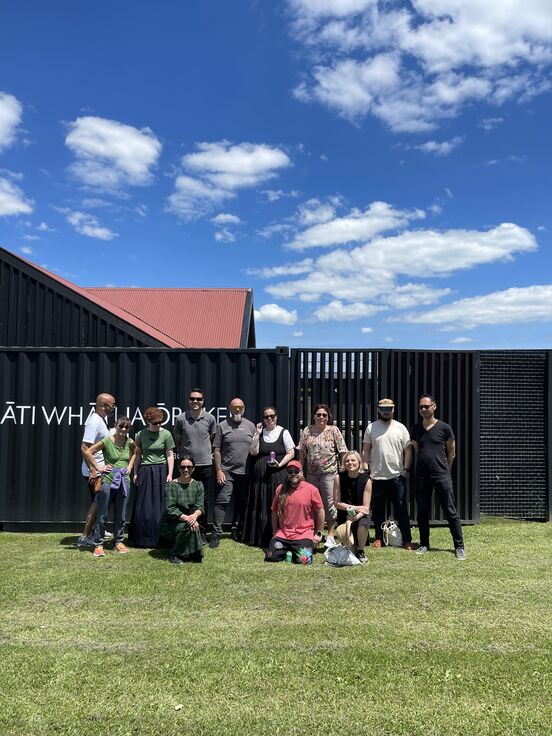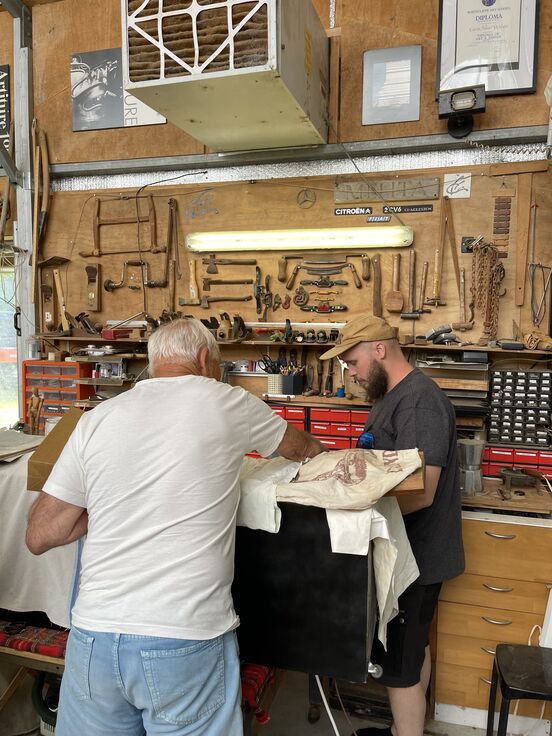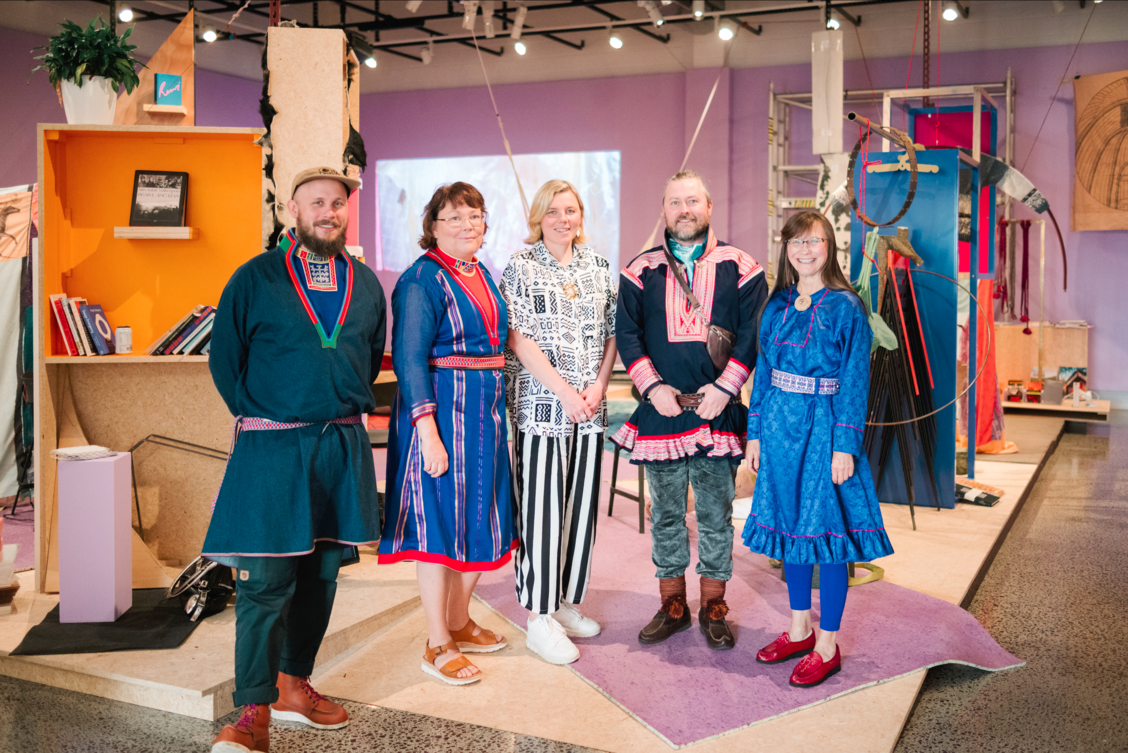-
Author
Zoe Black -
Date
12 Feb 2025
Announcement
Sápmi to Aotearoa: International Exchange Programme
Indigenous knowledge in architecture and design practice across the hemispheres
In 2024, Objectspace received funding from Nordisk Kulturfond to develop a project with the aims of connecting Aotearoa with Sápmi and creative practitioners advocating for Indigenous knowledge in architecture and design practice. Sápmi describes the traditional territory covering the northern regions of Norway, Sweden, Finland and the Kola Peninsula in Russia of the Indigenous Sámi people.
The connection between Objectspace, Aotearoa and Sápmi has developed through our ongoing collaborations with Norwegian Crafts that include visits, exhibitions, seminars and publishing. This project was an opportunity for Objectspace to host in Aotearoa some of the amazing Sámi practitioners we have met over the past seven years working with Norwegian Crafts.
The Sápmi to Aotearoa project focuses on sites of learning through the lens of Indigenous architecture and design. Beginning with baby cradles and spanning out to consider community places, libraries and gathering spaces, the project considers how Indigenous knowledge systems are embedded deeply in Māori and Sámi approaches to architecture and design.
The project was led by Sámi architect and artist Joar Nango, Professor in Duodji Gunvor Guttorm and Zoe Black from Objectspace. Nango and Guttorm together with collaborators – Eveliina Sarapää, Magnus Antaris Tuolja and Katarina Spik Skum – were invited to travel to Aotearoa to meet creative practitioners, participate in studio and site visits and learn more about contemporary Māori architecture practice. This experience led to two exhibitions which opened at Objectspace in December 2024.
The group’s time in Aotearoa began at Ōrākei Marae with a welcome from Tom Irvine, Graham Tipene and Anahera Rawiri from Ngāti Whātua Ōrākei. Starting the journey at Ngāti Whātua Ōrākei was vital for the group to gain an understanding of the history of the city and Objectspace’s relationship with Ngāti Whātua Ōrākei as mana whenua of the land on which the gallery sits. The group was joined by members of Jasmax and Christian Hampson of Yerrabingin and we gratefully acknowledge the kōrero and manaaki offered by Ngāti Whātua Ōrākei.
The group then headed north to meet Carin Wilson and Jade Kake at Pukeruru and ĀKAU in Kaikohe. They generously shared their experiences working as designers and architects, and their shared common focus on championing the weaving of mātauranga Māori into contemporary design to strengthen hauora outcomes for Indigenous peoples.
During the programme there was an intention to reflect on the past to understand the continual influence of Te Tiriti and the traditional knowledge that is drawn on today in contemporary practice. We were fortunate to share time with Pena Makoare for a deep dive at Te Kōngahu Museum of Waitangi, scour the collections of Te Papa Tongarewa with Cameron Woolford and have a close view of Nuku Tewhatewha, the pātaka whakairo (carved storehouse) at the Dowse Art Museum with Karl Chitham. The construction methods used in pātaka were of special interest to Joar and Magnus as a similar storehouse on slits is traditional in Sámi building.
In Pōneke we connected with practitioners to consider how Māori knowledge is manifesting in the built environment here and now. We looked at buildings that shape community, education spaces and the cityscape, alongside buildings that highlight the legacy of architects Rewi Thompson and John Scott. Visits included Massey University Te Ara Hihiko with Katherine Dean of Athfield Architects, Futuna Chapel with Nick Bevin and Te Wharewaka o Pōneke with Michael Bennett. Wellington’s iconic City to Sea bridge captured the group’s attention and its potential demolition a recurring talking point.
Back in Tāmaki Makaurau the focus switched to presenting two exhibitions, weaving together the experience of being in Aotearoa, new friendships and a coalescing of Indigenous knowledge.
Joar Nango’s Building an archive of Indigenous architecture is a continuation of his ongoing project, Girjegumpi, in process since 2018. At Objectspace, featuring constructions created with Joar’s proclivity for using what’s on hand and with creative input from Eveliina, Magnus and Katarina, a space is offered to sit, read, and contemplate how architecture exists from an Indigenous worldview.
Before the exhibition opened, we gathered a group of architects to discuss key texts that had been influential to their practice. These became part of the library that forms the exhibition and intertwined an understanding of Te Moana-nui-a-Kiwa through this iteration.
Gunvor Guttorm, along with Aotearoa collaborators Tanya Reihana White, Jasmine Te Hira and Ngaroma Riley presented Architecture of Aroha alongside Joar’s exhibition. Two baby sleeping vessels from te ao Māori and Sápmi, the wahakura and the gietkka, were brought together to illustrate how we consistently conceptualise, innovate, and finely-tune designs to ensure the protection and prosperity of families. Gunvor carved a new gietkka with Ngaroma Riley while here and included pāua, New Zealand coins and a muka mattress to reflect her time in Aotearoa.
The Sápmi to Aotearoa project shows the possibilities and power of strengthening Indigenous knowledge together. Through sharing time, culture and understandings, books, making and taonga, we can see the potential future for Sápmi, Aotearoa and Indigenous peoples worldwide when there is an understanding that honouring Indigenous knowledge is good for all.
Special thanks to Telly Tuita, Stevei Houkāmau, Jamie Berry, Johnson Witehira, Jenney Wilson and Whare Timu.

Gathering during Building an archive of Indigenous knowledge, photograph by David St George

Visiting Ngāti Whātua Ōrakei

Magnus Antaris Tuolja and Carin Wilson in Carin's workshop

Visiting Waitangi grounds with Bernard Makoare

Gunvor Guttorm and Ngaroma Riley carving a giettka at Te Tuhi, photograph by Jinki Cambronero

Magnus Antaris Tuolja, Katarina Spik Skum, Eveliina Sarapää, Joar Nango and Gunvor Guttorm, photograph by David St George